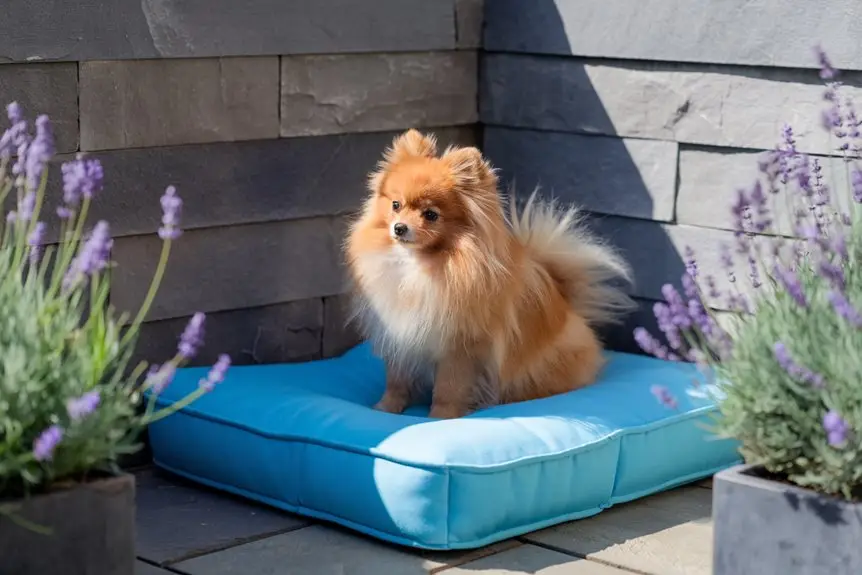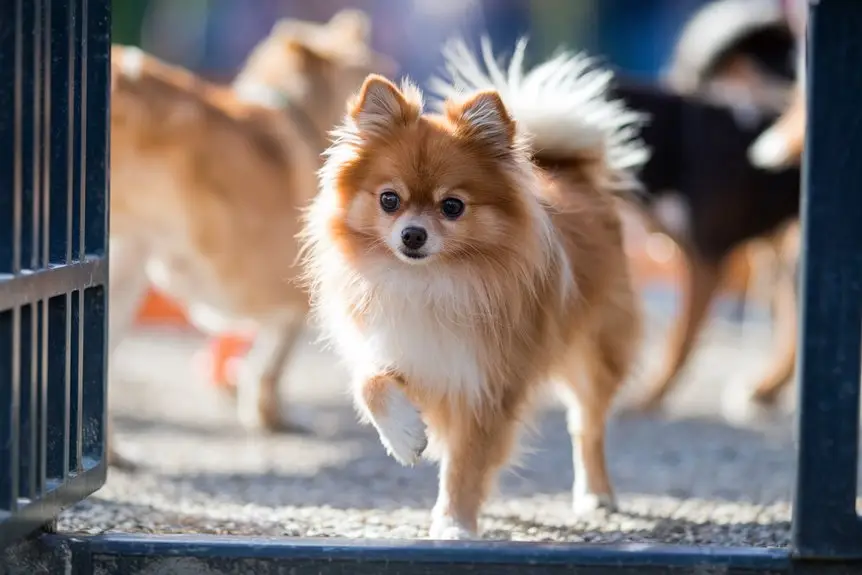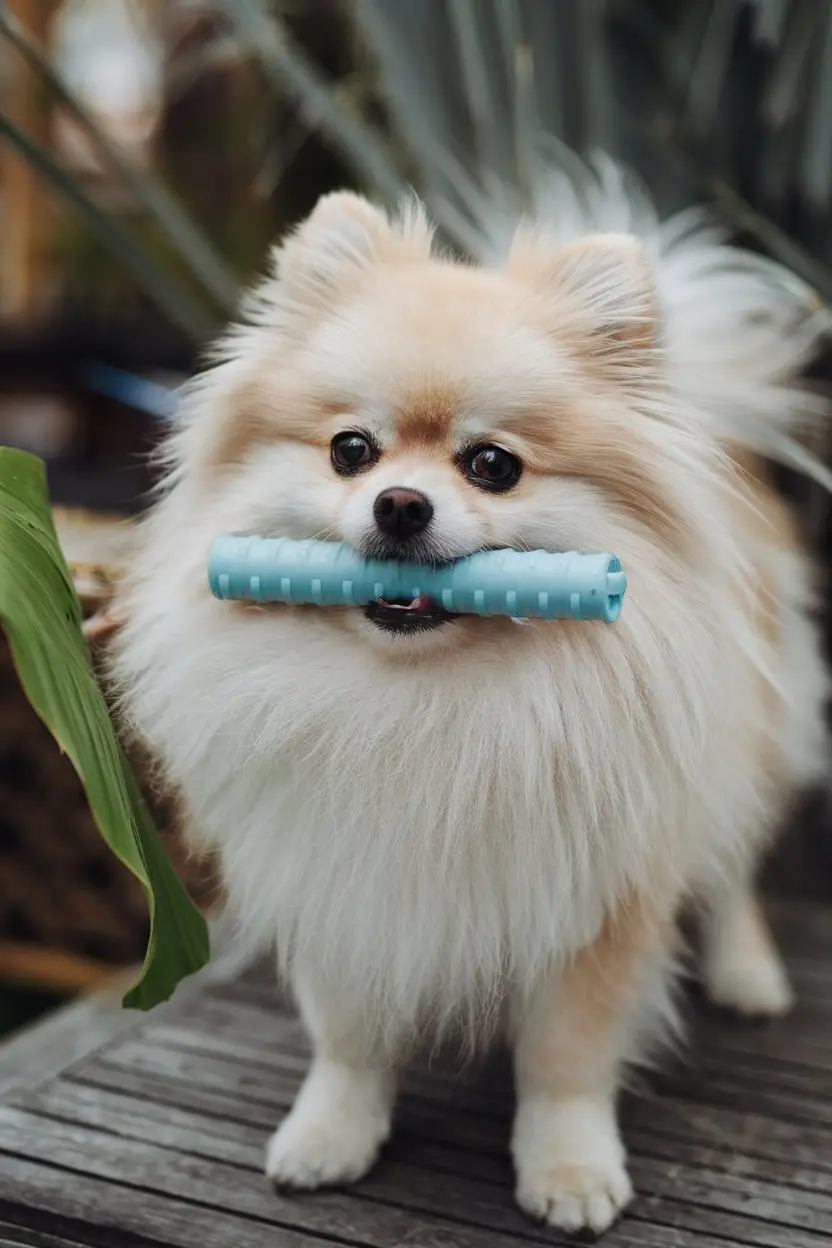Getting your Pom used to new places works best when you start from their comfy spot at home. Let your fluffy friend check things out in their own time – toss some yummy treats their way and give lots of happy words when they're being brave! Keep an eye out if they seem worried (you'll notice their ears going flat or tail tucking). When your pup seems overwhelmed, it's totally fine to take little breaks in their safe space.
Remember to keep training fun and quick – mixing up different treats helps keep them interested! There's no need to rush – some Poms take longer than others to feel comfortable with new stuff. Once you get these basics down, you'll have an adorable little buddy who's ready to go on adventures with you!
Start With Familiar Spaces

Starting off in places you know is the best way to get your Pom used to new stuff. Your little fluffball will do way better when you take baby steps, beginning right at home where they're most relaxed.
Set up a nice, quiet corner and let them meet your family members one at a time – each person can give treats to make your pup feel good about meeting them. Since Pomeranians are naturally curious dogs, they'll likely be interested in exploring these new interactions at their own pace. A gradual introduction plan helps minimize stress for both your Pom and existing family pets.
Once your Pom's feeling comfy at home, you can branch out with quick trips to calm spots like your buddy's place or a quiet park.
Bring along their special toy or blanket – it's like having a bit of home with them. Keep an eye on how they're acting and don't rush things if they seem nervous.
Give them lots of treats when they're being calm and chill, and never push them into scary situations. Just let your little Pom show you when they're ready to try new things.
Build Trust Through Small Steps

Building trust with your little Pom is all about taking your time and sticking with it as they get used to new stuff. A super helpful way to get them to trust you is keeping things predictable while making tiny changes here and there.
First up, set up a cozy spot where your fluffy buddy can chill when things get too much.
Then, bit by bit, help them explore beyond their comfort zone by mixing in new experiences slowly. Keep an eye on how they're acting – if you see them walking back and forth or breathing really fast, just pull back and take it slower.
Don't forget to give your Pom lots of yummy treats and loving words when they're brave about new things.
When you show them love for being confident, it helps build real trust and makes them feel like they truly belong in your family.
Try incorporating puzzle toys during playtime to keep their mind engaged while building confidence in new situations.
Positive Rewards Matter

Training your Pom is way easier when you use positive rewards – they really work wonders for getting good behavior and helping your pup feel confident in new places.
You can mix it up with different rewards like yummy treats, happy words, and fun toys to teach them what you want while getting closer to your little buddy.
Just make sure you time those rewards right – give them right after your Pom stays calm or listens to you in new spots.
When you're checking out unfamiliar places together, grab some extra-special treats and pair them with excited praise like "Good dog!" to make everything feel super positive.
Start by giving lots of treats early on, then slowly switch to more praise as your pup gets more comfortable.
Keep training quick and regular, and skip any harsh stuff that might stress them out.
When you stay patient and gentle, your Pom will feel great about exploring new places with you.
Mental stimulation activities can help reduce anxiety and destructive behaviors when introducing your Pom to new environments.
Watch Body Language Signals

Watching your Pom's body language helps you get what they're feeling when they're in new places. Look for stress signs like when their ears go flat, their tail tucks under, or they crouch down – that means your little buddy needs some extra love.
If you spot them standing with stiff legs while leaning forward or giving that intense stare, they might be getting defensive about being somewhere new.
Keep an eye out for happy faces – like when their mouth is relaxed and slightly open, or their ears point forward. That's your Pom showing they're starting to feel more at home.
If they start growling quietly or pull their lips back, get them out of there right away – they're saying they don't like what's going on.
Your Pom's mood can switch up pretty fast, so stay alert to what they're telling you through their body signals. This way, you'll know exactly when to step in and help them feel safe and comfy.
Using positive reinforcement during these new experiences will help your Pom build confidence and overcome anxiety in unfamiliar settings.
When to Take Breaks

Taking breaks when introducing your Pom to new stuff is super important – it can totally make the difference in how well they adjust! When your little fluff ball starts going crazy with barking, walking in circles, or just freaking out, that's your cue to hit pause and switch things up.
Keep an eye out for when your pup needs a breather – you'll see them getting anxious or just not wanting to deal with what's around them. If they're trying to hide or getting way too excited, it's totally fine to take a step back. Just give them their comfy spot where they can chill and reset.
When you're taking these breaks, just ease back into things slowly and reward them for being brave. You're not giving up – you're actually helping them win in the long run by keeping scary stuff and bad behavior from happening.
Take it easy, be super gentle, and never push your little buddy to do more than they're ready for. Since Pomeranians can develop behavioral changes that signal underlying health issues, staying attentive to their stress responses during introductions is crucial.
Frequently Asked Questions
How Long Should Each New Environment Introduction Session Last?
Ready to jump in for hours? Nope! Keep it short and sweet with 5-10 minute sessions at first – your pet will thank you for not pushing too hard. As they get comfy and start showing more tail wags and relaxed behavior, you can slowly make the sessions longer.
What Age Is Too Late to Start Environmental Socialization?
Starting after 14 weeks means you won't get the same awesome results, and waiting past 16 weeks can be pretty tricky. It's not totally hopeless if you start later, but pups learn and adapt way better when they're younger – that sweet spot is before they hit 14 weeks old.
Should I Carry My Pomeranian or Let Them Walk in New Places?
Like any curious pup learning their way around, mix up both options: scoop them up when things look sketchy or they're tired, and let them walk to sniff and check things out. You get the perks of both – it's what other Pom owners swear by!
How Many New Environments Should I Introduce per Week?
Taking your pup to 2-3 fresh spots each week hits that sweet spot – it's enough to get them used to new places but not so much that they freak out. Keep it nice and steady so they can build up their confidence without getting stressed or nervous.
Can Bad Weather Affect My Pomeranian's Adaptation to New Environments?
Bad weather can totally mess with your Pom's ability to get used to new places. Keep an eye on how your little buddy feels when the weather's rough – super hot days or freezing temps can make them more nervous and less willing to check out unfamiliar spots. It's like trying to make friends when you're already uncomfortable – not the easiest thing!




